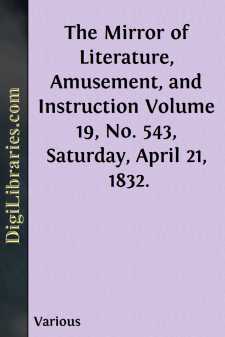Categories
- Antiques & Collectibles 13
- Architecture 36
- Art 48
- Bibles 22
- Biography & Autobiography 813
- Body, Mind & Spirit 142
- Business & Economics 28
- Children's Books 17
- Children's Fiction 14
- Computers 4
- Cooking 94
- Crafts & Hobbies 4
- Drama 346
- Education 46
- Family & Relationships 57
- Fiction 11829
- Games 19
- Gardening 17
- Health & Fitness 34
- History 1377
- House & Home 1
- Humor 147
- Juvenile Fiction 1873
- Juvenile Nonfiction 202
- Language Arts & Disciplines 88
- Law 16
- Literary Collections 686
- Literary Criticism 179
- Mathematics 13
- Medical 41
- Music 40
- Nature 179
- Non-Classifiable 1768
- Performing Arts 7
- Periodicals 1453
- Philosophy 64
- Photography 2
- Poetry 896
- Political Science 203
- Psychology 42
- Reference 154
- Religion 513
- Science 126
- Self-Help 84
- Social Science 81
- Sports & Recreation 34
- Study Aids 3
- Technology & Engineering 59
- Transportation 23
- Travel 463
- True Crime 29
The Mirror of Literature, Amusement, and Instruction Volume 19, No. 543, Saturday, April 21, 1832.
by: Various
Categories:
Description:
Excerpt
MELROSE ABBEY
(From a finished sketch, by a Correspondent.)These venerable ruins stand upon the southern bank of the Tweed, in Roxburghshire. The domestic buildings of the monastery are entirely gone; but the remains of the church connected with, as seen in the above Engraving, are described by Mr. Chambers as "the finest specimen of Gothic architecture and Gothic sculpture of which this country (Scotland) can boast. By singular good fortune, Melrose is also one of the most entire, as it is the most beautiful, of all the ecclesiastical ruins scattered throughout this reformed land. To say that it is beautiful, is to say nothing. It is exquisitely—splendidly lovely. It is an object of infinite grace and immeasurable charm; it is fine in its general aspect and in its minutest details; it is a study—a glory." We confess ourselves delighted with Mr. Chambers's well-directed enthusiasm.
A page of interesting facts towards the history of the Abbey will be found appended to the "Recollections" of a recent visit by one of our esteemed Correspondents, in The Mirror, vol. x., p. 445. In the present view, the ornate Gothic style of the building is seen to advantage, but more especially the richness of the windows, and the niches above them: the latter, from drawings made "early in the reign of King William," were originally filled with statues; and, connected with the destruction of some of them, Mr. Chambers relates the following anecdote "told by the person who shows Melrose:"
"On the eastern window of the church, there were formerly thirteen effigies, supposed to represent our Saviour and his apostles. These, harmless and beautiful as they were, happened to provoke the wrath of a praying weaver in Gattonside, who, in a moment of inspired zeal, went up one night by means of a ladder, and with a hammer and chisel, knocked off the heads and limbs of the figures. Next morning he made no scruple to publish the transaction, observing, with a great deal of exultation, to every person whom he met, that he had 'fairly stumpet thae vile paipist dirt nou!' The people sometimes catch up a remarkable word when uttered on a remarkable occasion by one of their number, and turn the utterer into ridicule, by attaching it to him as a nickname; and it is some consolation to think that this monster was therefore treated with the sobriquet of 'Stumpie,' and of course carried it about with him to his grave."
The exquisite beauty and elaborate ornament of Melrose can, according to the entertaining work already quoted, be told only in a volume of prose; but, as compression is the spirit of true poetry, we quote the following descriptive lines:
If thou would'st view fair Melrose aright,
Go visit it by the pale moonlight;
For the gay beams of lightsome day
Gild but to flout the ruins gray.
When the broken arches are dark in night,
And each shafted oriel glimmers white;
When the cold light's uncertain shower
Streams on the ruin'd central tower;
When buttress and buttress, alternately,
Seem framed of ebon and ivory;
Wnen silver edges the imagery,
And the scrolls that teach thee to live and die;
When distant Tweed is heard to rave,
And the howlet to hoot o'er the dead man's grave,
Then go—but go alone the while—
Then view St....












